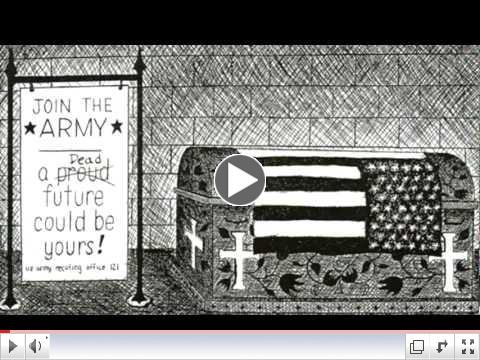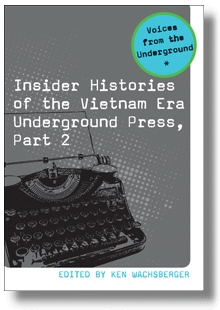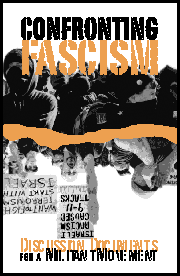Dialogue & Initiative 2012 The new annual edition of our journal of discussion and analysis is now out. More than 130 pages, it includes 13 articles related to the Occupy! movement, as well as seven others vital to study in this election year. Cost is $10 plus shipping. Or get one by becoming a sustainer. Click the title to buy it directly.
|
New Issue of Mobilizer

Check out what CCDS has been doing...
|
Blog of the Week: ColorLines 
Brooklyn's Anti-Racist Billboard Campaign
|
Lost Writings of SDS..
Revolutionary Youth the the New Working Class: The Praxis Papers, the Port Authority Statement, the RYM Documents and other Lost Writings of SDS
Edited by Carl Davidson 
Changemaker, 273pp, $22.50
For the full contents, click the link and view 'Preview' under the cover graphic.
|
|
By Randy Shannon, CCDS

"Everyone has the right to work, to free of employment, to just and favorable conditions of work and to protection against unemployment."
- United Nations Universal Declaration of Human Rights, December 10, 1948
I. Introduction
The "Great Recession" that began in 2007 has caused the greatest percent of job losses since the Great Depression of 1929. This crisis is the end of an era of unrestrained 'neo-liberal' capitalism that became public policy during the Reagan administration. The crisis marks a new level of instability with the growth of a global financial elite that targeted US workers and our trade unions after World War II.
|
|
Order Our
Full Employment Booklets
 |
...In a new and updated 2nd Edition
Capitalism may well collapse under its own excesses, but what would one propose to replace it? Margaret Thatcher's mantra was TINA...There Is No Alternative. David Schweickart's vision of "Economic Democracy" proposes a serious alternative. Even more fundamentally, it opens the door to thinking about alternatives. His may or may not turn out to be the definitive "successor system," but he is a leader in breaking out of the box. |
|
Quick Links...
CCDS Discussion |
Sex and the Automobile in the Jazz Age

By Peter Ling in History Today: 'Brothels on wheels' thundered the moralists but Peter Ling argues the advent of mass motoring in the 1920s was only one of the changes in social and group relationships that made easier the pursuit of carnal desire.
|
 A Memoir of the 1960s by Paul KrehbielAutumn Leaf Press, $25.64 A Memoir of the 1960s by Paul KrehbielAutumn Leaf Press, $25.64 | | Shades of Justice Video: Bringing Down a President, Ending a War |
|
Carl Davidson's Latest Book:
New Paths to Socialism

Essays on Mondragon, Marx, Gramsci and the Green and Solidarity Economies |
Solidarity Economy:What It's All About

Edited by Jenna Allard, Carl Davidson and Julie Matthaei
Buy it here...
|

Voices from the Underground Press of the 1960s, Part 2- Foreword by Susan Brownmiller
- Preface by Ken Wachsberger
$37.50 + $6 shipping
|
|
Discussion Documents for a Militant Movement

By Don Hamerquist
|
|
|
|
An Invitation to CCDSers and Friends...
 Drones and Guns, Frying Our Brains
We're the Committees of Correspondence for Democracy and Socialism...Do you have friends who should see this? Pass it on...Do you have a blog of your own? Others you love to read every day? Well, this is a place where you can share access to them with the rest of your comrades. Just pick your greatest hits for the week and send them to us at carld717@gmail.com!
Most of all, it's urgent that you defend voter rights, plan for 2014 races now, oppose austerity, make solidarity with the Occupy! movement and end the wars! We're doing more than ever, and have big plans. So pay your dues, make a donation and become a sustainer. Do it Now! Check the link at the bottom...
|

Abdulrahman al-Awlaki, U.S. Teenager Killed by Drone
By Amy Davidson
The New Yorker
About a third of the way into in a Department of Justice white paper explaining why and when the President can kill American citizens, there is a citation that should give a reader pause.
It comes in a section in which the author of the document, which was given to members of the Senate Intelligence and Judiciary committees last year-and obtained by Michael Isikoff, of NBC, on Monday-says that this power extends into every country in the world other than the United States, well beyond those where we are engaged in hostilities.
The reference is to an address that John R. Stevenson, a State Department legal adviser, gave before the Association of the Bar in New York in May, 1970, to justify the Nixon Administration's incursion into Cambodia. Does that make everyone, or anyone, feel better about what the Obama Administration has decided it can do, or the extent to which it thought through the implications, unintended consequences, precedents, and random reckless damage it may be delivering with this policy?
The white paper is a summary of something that had long been sought: the Obama Administration's legal analysis of its killing of Anwar al-Awlaki, an American citizen in Yemen who was hit by a drone strike in 2011. That memo has been described to reporters but never released. It needs to be. The question isn't whether al-Awlaki, who worked with Al Qaeda, was an innocent-the question is at what point he crossed the line and became killable without any judicial proceedings, and when, by extension, the rest of us could be put on a "kill list." John Brennan, the President's nominee for head of the C.I.A., has been deeply involved in the drone and targeted-killing programs. His confirmation hearings are this week, and the white paper offers a guide to some of the questions Senators should ask him. (As the Washington Post notes, it may have been leaked for that purpose.) The paper pretends to lay out a careful argument,
"...a legal framework for considering the circumstances in which the U.S. government could use lethal force in a foreign country outside the area of active hostilities against a U.S. citizen who is a senior operational leader of al-Qaida or an associated force of al-Qaida-that is, an al-Qaida leader actively engaged in planning operation to kill Americans."
The three conditions for killing, the paper says, are that such a person poses an "imminent threat"; that capture is "infeasible"; and that the killings are "consistent with applicable law of war principles." But once it has defined its terms, the restraints all but disappear. There is never a strong definition of "senior operational leader," or even-maybe especially-of what counts as an "associated force," the affiliation that makes people who are not part of Al Qaeda eligible for assassination. (A footnote mentions "co-belligerents," but that itself can be a flexible designation.) The paper notes that it "does not attempt to determine the minimum requirement" for killing an American, and that is certainly true....(Click title for more)
|
|
|
A bulletin board at the Inner-City Muslim Action Network in Chicago reflects the omnipresence of violence in the city's black neighborhoods. In January, 42 people were killed, after a 2012 in which the city recorded a record number of homicides. Photo: Jamilah King
By Jamilah King
ColorLines
When I meet Bilal, a 38-year-old security guard at Inner-City Muslim Action Network in Chicago, it's hard to tell that he spent 15 years in prison for first degree murder.
He's a family man now, married and raising three girls, and he's soft spoken and a little pudgy around the middle. Nearly two decades ago, he was a leader of a splinter group of one of Chicago's most notorious street gangs, the Gangster Disciples. After converting to Islam in prison and changing his name from Anthony, he committed himself to trying to prevent young men from his neighborhood from following in his footsteps and eventually found his way to CeaseFire, a group that works to stop conflicts before they erupt into violence.
Driving with him through the South Side community of Englewood on the way to take his infant daughter and school-age stepdaughters home, it's clear that an interrupter's work doesn't end when a conflict does. He pulls up to a group of young men on the corner, slows the car, and ask, "Y'all alright?"
Then he continues on down the street and points to a white SUV in front of us, telling me that the owner was shot and killed about a month ago. He pulls up alongside it and a black woman in her 30's with neatly pressed hair and light-colored sunglasses covering tired-looking eyes rolls down the window. She tells Bilal that she's thankful to be up today. At a bus stop across the street, a group of four teenage girls laugh and chatter with each other, all wearing matching white sweatshirts with "RIP Chris" scrawled across the front in sparkling red letters. Loss is so common here that it's become fashionable.
On January 29, 15-year-old Hadiya Pendleton became the city's new symbol of loss. Just days removed from performing with a high school group at President Obama's second inauguration in Washington, DC, Pendleton was shot and killed as she stood with friends in a neighborhood park. That another young, black life was so senselessly ended-just days after helping to celebrate the most powerful black politician in history-has added yet another macabre twist to Chicago's tale of tragic deaths.
In 2012, the city recorded 506 homicides, an increase of more than 16 percent over 2011. The New York Times reported that those homicides were isolated to certain geographic areas in the city, indicative of longstanding segregation and a city that remains divided. In 2013, the killings have continued at a frightening pace; in January alone, 42 people were killed by guns. That's the worst rate of homicide in 10 years.
"There's a needed coordination on the national level at this point," Cathy Cohen, a political scientist at the University of Chicago and founder of the Black Youth Project, said on MSNBC recently. "People are trying to do whatever they can, from community groups, NGO's, to faith-based communities, but there's a leadership and coordination that's needed from the national level." Cohen was speaking to her group's petition to get President Obama to "come home" to Chicago to address the violence. ...(Click title for more)
|
|
By Teddy Partridge
FireDogLake
Feb 6, 2013 - The House Progressive Caucus has shown the way to balance in the debate on how to avoid the sequester. It's important to remember that the first "fix" was all program cuts, and the second "fix" reduced the proportion of program cuts from 100% to 70% - but the entire enterprise is still weighted to the GOP program-cuts side.
Here are the Progressive Caucus leaders, explaining this:
"Almost $2 trillion has been cut over the past two years from teachers, firefighters, police officers, loans for college students, and infrastructure investments," Rep. Ellison said. "The American people shouldn't continue to pay the price for massive tax breaks for millionaires and billions of dollars in subsidies to oil companies."
"If one-to-one is really our goal, why don't we make the entire budget and investment process one-to-one instead of restricting it to this current round?" Rep. Grijalva said. "We've cut non-defense budgets to the bone. There are simply no major savings hiding in school lunch or nurse training programs. We need investments. The Beltway refusal to make job creation our number one priority is a scandal, and the Balancing Act is the right way to fix it."
Greg Sargent shows why even "winning" as defined within the Beltway is actually losing for Democrats:
"Even if the parties reach a deal in the third round of deficit reduction to avert the sequester with something approaching an equivalent sum of spending cuts and new revenues, the overall deficit reduction balance would still be heavily lopsided towards Republicans. Yet they continue to insist on resolving round three only through cuts, anyway."
Here's what an actual 50/50 split between cuts to programs and revenue would look like. Unsurprisingly, in order to even things up at this late stage, it's revenue-heavy. It has to be:
"The Congressional Progressive Caucus announced today that it is introducing legislation to cancel the automatic spending cuts - known as the "sequester" - that are scheduled to take place at the beginning of March. The CPC's Balancing Act would replace the scheduled spending cuts with more than $900 billion in new revenues and nearly $300 billion in cuts to the defense budget."
The Balancing Act would result in $960 billion in new revenue, generated from closing tax loopholes for corporations and the wealthy. It ends the carried interest loophole that benefits wealthy hedge fund managers, closes tax loopholes that encourage corporations to send profits to offshore tax havens, ends the $4 billion in annual subsidies to Big Oil companies, and closes loopholes that benefit buyers of private jets and yachts. It also limits deductions for wealthy taxpayers and closes loopholes in the estate tax.
Of course, there's lots of lobbyists working Capitol Hill hard for the Big Oil companies, as well as the private jet owners and estate-tax-worriers. So this plan also works to save some of the drastic cuts to the Pentagon. It would be wise for the defense industry to pay attention here:
"The proposal also cuts $278 billion from defense spending, a dramatic reduction from the $500 billion in cuts the Pentagon would face under the sequester. Added together with previous deficit reduction efforts, the Balancing Act would equalize cuts to defense and domestic spending while also making the overall package of deficit reduction measures equal parts revenue and spending cuts...."
There's a chart at the link that shows how this works, and we really need to do things this way.  It's time to compromise, people. And this 50/50 compromise is the best compromise for everyone.
Additionally:
"The Balancing Act also includes investments into infrastructure and education meant to bolster the economic recovery. It would reinstitute the Making Work Pay tax credit, which would provide up to $800 to low- and middle-income families, for one year at a cost of $61 billion. It would also spend $55 billion on education investments - a measure the CPC says would prevent 280,000 teacher layoffs and modernize 35,000 public schools - and $160 billion in infrastructure investments. The CPC projects that such investments would create roughly 1 million jobs. Even with those investments, the Balancing Act would result in a total of $3.3 trillion in deficit reduction when added to already-enacted cuts and revenues."
Photo by vgm8383 under Creative Commons license
|
 Even after his death, Osama bin Laden thrives in the U.S.'s transformation into a lockdown state. Even after his death, Osama bin Laden thrives in the U.S.'s transformation into a lockdown state.
By Tom Engelhardt
Alternet.org
Consider Inauguration Day, more than two weeks gone and already part of our distant past. In its wake, President Obama was hailed (or reviled) for his "liberal" second inaugural address.
On that day everything from his invocation of women's rights ("Seneca Falls"), the civil rights movement ("Selma"), and the gay rights movement ("Stonewall") to his wife's new bangs and Beyoncé's lip-syncing was fodder for the media extravaganza. The president was even praised (or reviled) for what he took pains not to bring up: the budget deficit.
Was anything, in fact, not grist for the media mill, the hordes of talking heads, and the chattering classes?
One subject, at least, got remarkably little attention during the inaugural blitz and, when mentioned, certainly struck few as odd or worth dwelling on. Yet nothing better caught our changing American world. Washington, after all, was in a lockdown mode unmatched by any inauguration from another era -- not even Lincoln's second inaugural in the midst of the Civil War, or Franklin Roosevelt's during World War II, or John F. Kennedy's at the height of the Cold War.
Here's how NBC Nightly News described some of the security arrangements as the day approached:
"[T]he airspace above Washington... [will be] a virtual no-fly zone for 30 miles in all directions from the U.S. capital. Six miles of the Potomac and Anacostia Rivers will be shut down, with 150 blocks of downtown Washington closed to traffic, partly out of concern for car or truck bombs... with counter-snipers on top of buildings around the capital and along the parade route... [and] detectors monitoring the air for toxins... At the ready near the capital, thousands of doses of antidotes in case of a chemical or biological attack... All this security will cost about $120 million dollars for hundreds of federal agents, thousands of local police, and national guardsmen from 25 states."
Consider just the money. It's common knowledge that, until the recent deal over the renewal of the George W. Bush tax cuts for all but the richest of Americans, taxes had not been raised since the read-my-lips-no-new-taxes era of his father. That's typical of the way we haven't yet assimilated the new world we find ourselves in. After all, shouldn't that $120 million in taxpayer money spent on "safety" and "security" for a single event in Washington be considered part of an ongoing Osama bin Laden tax?
Maybe it's time to face the facts: this isn't your grandfather's America. Once, prospective Americans landed in a New World. This time around, a new world's landed on us.
Making Fantasy Into Reality
Bin Laden, of course, is long dead, but his was the 9/11 spark that, in the hands of George W. Bush and his top officials, helped turn this country into a lockdown state and first set significant portions of the Greater Middle East aflame. In that sense, bin Laden has been thriving in Washington ever since and no commando raid in Pakistan or elsewhere has a chance of doing him in....(Click title for more)
|
|
Speigel Online
Is the new Czech president from the left wing or the right wing? Neither, say German commentators. Rather, Milos Zeman is a populist who stopped at nothing, not even at the reopening of historical wounds between his country and Germany, on his way to Prague Castle.
Voters in the Czech Republic elected leftist ex-Prime Minister Milos Zeman as their next president over the weekend in the country's first ever direct presidential election, after a bitter campaign marked by populism and battles over the country's history.
Zeman, 68 years old and a member of the Communist Party prior to the 1968 Soviet invasion of Czechoslovakia, is more sympathetic to the Czech Republic's European Union membership than his predecessor, Vaclav Klaus, who stays in office until March 7. He was elected in a run-off election against current Foreign Minister Karel Schwarzenberg with 54.8 percent of the vote, winning big among poorer and rural voters.
Klaus' vociferous euro-skepticism pushed the country of 10.5 million people to the bloc's fringe. Though the office of the president has little influence in day-to-day politics, it does have the power to appoint prime ministers, central bank leaders and judges, and a more EU-friendly president could serve to heal some of the country's rifts with the bloc.
Zeman said he wanted to unify the country as "the voice of all citizens" and the "president of the bottom 10 million." His campaign often called into question the national allegiances of his opponent, current Foreign Minister Karel Schwarzenberg, who belongs to an old aristocratic family and lived in exile in Austria during the communist rule of 1948-1989.
The German press paid particular attention as the issue of the Sudeten Germans arose in the campaign. After World War II, Czechoslovakia expelled three million ethnic Germans from its borders, something Schwarzenberg equated to a war crime. Some of those Germans are seeking to reclaim properties that were confiscated as part of the expulsions, and Zeman accused his opponent of backing their efforts. There is some concern that Zeman's penchant for populism could reignite old wounds.
Schwarzenberg said Zeman won the election by lying. "The difference of 10 percentage points was the result of this kind of campaign," he said. "It is impossible to defend against certain types of bad-mouthing."...(Click title for more)
|
 | Sundance (2013) - Blood Brother Trailer -
|
By Carl Kurlander
Pittsburgh Post-Gazette
Jan 27, 2013 - Fred Rogers once said that our greatest challenge was to "try and make good attractive." He would be truly proud today of some young men from his hometown as headlines across the world read Blood Brother wins Grand Jury Prize and Audience Award for Best Documentary at Sundance.
The film is a Rocky underdog story, but one with a spiritual twist whose entire aim from the beginning was to amplify good in the world, as the film follows Rocky Braat, a young man from Pittsburgh who took a different path, heading to India where his journey and those of a group of young children with HIV, became entwined, and in so doing, thanks to the masterful work of some fellow Pittsburghers who documented his experience, will hopefully now inspire millions. And for those of us in Pittsburgh, the story is even more remarkable.
I first became aware of the film that would become Blood Brother a couple of years ago when visiting the downtown offices of Michael Killen, another Pittsburgher who had come back here after a career in L.A. to open up ANIMAL, an extraordinarily creative media firm which has done award winning national work which got early attention for making the Taco Bell Chihuaua talk. (see http://animalvfx.com) Michael is a big believer in Pittsburgh talent and on my visit, he introduced me to a couple of recent graduates from the Art Institute, Steve Hoover and Danny Yourd. They were packing a bag with film equipment as they mentioned off-handedly, that Steve was on his way to India to visit their fellow Art Institute grad, Rocky Braat, who had left Pittsburgh to go work at an orphanage where all the children were HIV positive. It was one of those sentences that seemed larger than one could absorb, and, though one could sense their passion, they said it with this casualness, as if they were going to an away Steelers game, that seemed to belie the intensity of this endeavor.
Cut to a year later, when I was visiting Michael and his colleague Kathy Dziubekas as Steve was editing the footage they had gathered. You could tell with each frame how this was something special. The story of Blood Brother is a story of selflessness, of friendship, of how caring can be infectious. We all know that there are sad stories that happen every day on the planet, and can feel so helpless, but here Rocky was caring about these kids who had become his family. I don't want to say too much as it seems inevitable that soon this story which inspired the audience at Sundance will be inspiring many, many others. ...(Click title for more)
|
 By Lynn Neary
NPR Morning Edition
Woody Guthrie wrote thousands of songs in his lifetime - but as far as anyone knows, he only wrote one novel. Recently discovered, House of Earth is the story of a young couple living in the Texas Panhandle in the 1930s. They dream of building a house that will withstand the bitter winds and ever-present dust that constantly threaten the flimsy wooden shack they call home.
The novel is being released by Johnny Depp's new publishing imprint at HarperCollins, Infinitum Nihil. It was Depp's publishing partner, historian and author Douglas Brinkley, who tracked down the lost novel after he stumbled across a reference to it while doing research. When he sat down to read it, Brinkley could hear the same Woody Guthrie he had grown to love through his music.
"Woody Guthrie has something that every artist would dies for: a voice," says Brinkley. "You can read House of Earth and you know it's Woody Guthrie. You know it's coming from the heart."
When Woody Guthrie's daughter, Nora Guthrie, first read the book, she had a different reaction. "The opening chapter was so sexy," she says, laughing. "I just went, whoa, Dad, where are you going with this?"
Both Brinkley and Guthrie suspect that in part, it is the sexually explicit material in the book that kept it from being published after it was written in 1947.
And there was another reason: The book would have come out just as an era of virulent anti-communism was getting under way, so it was also most likely that politics kept it from being published. Because, Brinkley says, the book is both a love story and a polemic against the bankers and businessmen Guthrie blamed for keeping the poor, poor - a theme often heard in his music.
House of Earth is the story of struggling young sharecroppers Tike and Ella May. Nora Guthrie says her father has created a portrait of their life: sowing seeds, planting crops, making love, giving birth, and dreaming of creating a safe haven amid the dust storms and economic depression of the 1930s.
"These ideas of seeds and sex and procreation and earth, and farm language and things like that - adobe houses being built out of this combination of water and earth," muses Nora Guthrie, "that's what really struck me once again is how he hammers home this really rough and rich life."
Tike is determined to build a new house made of adobe, convinced that such a house will give them better protection from the unrelenting weather. Nora Guthrie says this idea of building adobe homes was one of her father's obsessions.
"He was fascinated with this whole idea of people being able to cheaply create homes that were stronger than the wooden homes that were being devastated during the dust bowl," she says. "So he had this long-term fascination, and when he had fascinations, he turned them into everything - he turned it into art, he turned it into letters, he turned it into lyrics."...(Click title for more)
|
|
Become a CCDS member today!
 The
time is long past for 'Lone Rangers'. Being a socialist by your self is
no fun and doesn't help much. Join CCDS today--$36 regular, $48
household and $18 youth. The
time is long past for 'Lone Rangers'. Being a socialist by your self is
no fun and doesn't help much. Join CCDS today--$36 regular, $48
household and $18 youth.
Better yet, beome a sustainer at $20 per month,
and we'll send you a copy of Jack O'Dell's new book, 'Climbing Jacobs
Ladder,' drawing on the lessons of the movement in the South in the
1950s and 1960s.
Solidarity, Carl Davidson, CCDS |
|
|